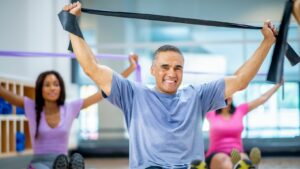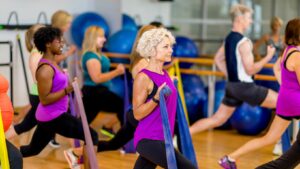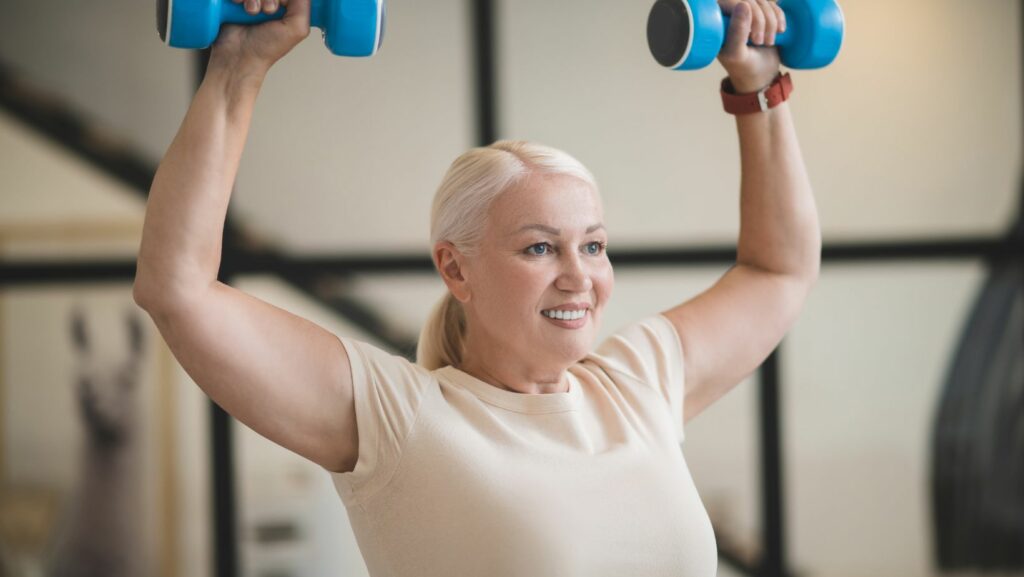Fitness Over 50
- Importance of Fitness: Staying active over 50 enhances cardiovascular health, mental clarity, and bone density while reducing the risk of chronic diseases.
- Mental Benefits: Regular exercise releases endorphins, which improve mood, combat anxiety and depression, and foster social connections through group activities.
- Effective Workouts: Low-impact exercises like walking, swimming, and yoga are recommended for maintaining fitness without excessive strain on joints.

- Strength Training Essentials: Incorporating bodyweight exercises and resistance bands 2-3 times a week is crucial for maintaining muscle mass and bone density.
- Nutrition Matters: A balanced diet rich in protein, calcium, vitamin D, and omega-3 fatty acids supports fitness and overall health in individuals over 50.
- Overcoming Challenges: Addressing physical limitations with modified exercises and setting achievable goals help in staying motivated and committed to a fitness journey.
As the years go by, staying fit becomes increasingly important for overall health and well-being. For those over 50, embracing fitness can lead to a more active lifestyle, improved mobility, and a greater sense of vitality. It’s never too late to start a fitness journey, and many are discovering the joy of movement at this stage in life.
With the right approach, individuals can enhance their strength, flexibility, and endurance, making everyday activities easier and more enjoyable. Whether it’s through walking, yoga, or strength training, finding the right fitness routine can transform lives and promote longevity. This article explores effective strategies and tips for maintaining fitness after 50, empowering readers to take charge of their health and embrace the benefits of an active lifestyle.
Importance Of Fitness Over 50
Fitness plays a crucial role in enhancing quality of life for individuals over 50. Physical activity improves cardiovascular health, mental clarity, and bone density. Regular exercise fosters muscle strength and flexibility, aiding in daily activities and reducing the risk of injuries.
Engaging in fitness activities also has significant mental health benefits. Exercise releases endorphins, which can alleviate symptoms of anxiety and depression, promoting a positive mindset. Social interactions during group classes or sports can combat loneliness, fostering community and emotional support.
In addition, fitness helps manage weight, which is vital as metabolism slows with age. Maintaining a healthy weight reduces the risk of chronic diseases such as diabetes, hypertension, and heart disease.
Tailoring workouts to individual capabilities ensures safety and efficacy. Simple activities like walking, swimming, and yoga can be modified to accommodate different fitness levels, making them accessible to everyone.
Prioritizing fitness after 50 supports long-term health and well-being. Combining strength training, aerobic exercises, and flexibility work creates a balanced approach, leading to sustained vitality and independence.
Benefits Of Staying Active
Staying active after 50 provides numerous health benefits that contribute to overall well-being. Regular physical activity positively impacts both physical and mental health, enhancing quality of life and longevity.
Physical Health Benefits
Staying active significantly improves cardiovascular health. Engaging in activities like walking, swimming, or cycling strengthens the heart and increases circulation. Enhanced bone density occurs with weight-bearing exercises, reducing the risk of osteoporosis. Strength training builds muscle mass, which naturally declines with age, aiding in better balance and coordination. Active individuals tend to maintain healthier weights, which lowers the risk of chronic diseases such as diabetes and hypertension. Flexibility exercises, such as yoga, improve mobility and decrease the likelihood of injury.
Mental Health Benefits
Staying active boosts mental clarity and cognitive function. Exercise releases endorphins, which enhance mood and alleviate symptoms of anxiety and depression. Regular physical activity promotes better sleep quality, leading to increased energy levels during the day. Social interactions gained through group classes foster connections that combat loneliness and enhance emotional well-being. Additionally, staying mentally engaged through fitness challenges can improve memory and stimulate cognitive resilience, contributing to long-term mental health.
Effective Workouts For Individuals Over 50
Fitness over 50 requires careful selection of exercises that enhance well-being while minimizing the risk of injury. The following sections detail effective workout strategies tailored for this age group.
Low-Impact Exercises
Low-impact exercises provide beneficial workouts while reducing strain on joints. Individuals over 50 can consider the following options:
- Walking: Engaging in brisk walking increases cardiovascular health and can be performed anywhere.
- Swimming: This activity offers a full-body workout with minimal joint stress, enhancing flexibility and strength.
- Cycling: Riding a stationary bike or cycling outdoors strengthens leg muscles while being easy on the knees.
- Tai Chi: This gentle martial art improves balance, flexibility, and coordination, helping prevent falls.
- Yoga: Different styles of yoga promote flexibility, strength, and relaxation, contributing to better overall health.
These options encourage movement without excessive strain, facilitating consistent activity.
Strength Training Recommendations
Strength training proves essential for maintaining muscle mass and bone density. Individuals over 50 should incorporate the following guidelines:
- Start with Bodyweight Exercises: Simple moves like squats, push-ups, and lunges utilize body weight to build strength without equipment.
- Use Resistance Bands: Resistance bands provide adjustable strength training options that are easy to use at home or in a gym setting.
- Focus on Major Muscle Groups: Targeting arms, legs, back, and core ensures balanced strength development and functional fitness.
- Limit Sessions to 2-3 Times a Week: Engaging in strength training 2-3 times a week allows for recovery while promoting muscle growth.
- Gradually Increase Weights: Progressing slowly with weights ensures safe improvement in strength and reduces injury risk.
These strength training recommendations promote safety and effectiveness, ensuring sustainable fitness journeys for individuals over 50.
Nutrition Tips For Fitness Over 50
Nutrition plays a vital role in supporting fitness for individuals over 50. A balanced diet enhances performance, recovery, and overall health.
Essential Nutrients
Individuals over 50 require specific nutrients to maintain optimal health.
- Protein: Prioritize lean sources like chicken, fish, beans, and legumes. Protein supports muscle repair and preservation. Aim for 1.2 to 2.0 grams of protein per kilogram of body weight daily.
- Calcium: Incorporate dairy products, leafy greens, and fortified foods to support bone health. Aim for 1,200 mg of calcium daily for women and 1,000 mg for men.
- Vitamin D: Include fatty fish, egg yolks, and fortified foods. Vitamin D aids calcium absorption. A daily intake of 800 to 1,000 IU is recommended.
- Fiber: Consume whole grains, fruits, and vegetables to promote digestive health. Aim for at least 25-30 grams of fiber daily.
- Omega-3 Fatty Acids: Add sources like walnuts, flaxseeds, and fatty fish. Omega-3s support heart health and reduce inflammation. Aim for two servings of fatty fish weekly.
Meal Planning Strategies
Strategic meal planning maximizes nutrition for individuals over 50.
- Balance Macronutrients: Include proteins, healthy fats, and carbohydrates in each meal for sustained energy. A balanced plate usually features a palm-sized portion of protein, a fist-sized portion of whole grains, and a variety of colorful vegetables.
- Plan Ahead: Prepare meals in advance to resist unhealthy options. Batch cooking can save time and ensure healthy choices throughout the week.
- Stay Hydrated: Drink adequate water daily to support metabolism and overall health. Aim for at least 8 cups (64 ounces) per day, adjusting for physical activity levels.
- Snack Smart: Choose healthy snacks like nuts, yogurt, or fruits to maintain energy levels. Incorporating small, nutrient-rich snacks can curb hunger and prevent overeating.
- Monitor Portions: Pay attention to portion sizes to prevent weight gain. Using measuring cups or a food scale may help maintain proper servings.
Common Challenges And Solutions
Individuals over 50 often face unique challenges regarding fitness. Identifying these challenges and implementing effective solutions can significantly enhance their fitness journey.
Overcoming Physical Limitations
Overcoming physical limitations involves targeted modifications and a gradual approach. Individuals may experience joint pain or reduced flexibility. Low-impact exercises, such as swimming or cycling, significantly reduce joint strain while maintaining cardiovascular health. Incorporating flexibility routines, such as gentle yoga or stretching, improves range of motion and decreases stiffness.
Using assistive devices, like resistance bands or stability balls, offers safe ways to perform strength training without heavy weights. Consultation with healthcare providers or fitness professionals helps individuals tailor workouts that consider personal health conditions, ensuring safety while encouraging progression.
Staying Motivated
Staying motivated requires setting achievable goals and celebrating small successes.  Individuals should establish specific, measurable fitness goals, such as walking a certain distance or completing a certain number of repetitions, to track progress.
Individuals should establish specific, measurable fitness goals, such as walking a certain distance or completing a certain number of repetitions, to track progress.
Joining group classes or fitness communities fosters social connections, making workouts enjoyable and providing accountability. Regularly varying workouts keeps routines fresh and exciting, preventing boredom. Establishing a consistent workout schedule aligns fitness activities with daily routines, reinforcing commitment. Using fitness apps or wearable devices helps monitor progress and provides a visual motivation boost.
More Fulfilling Lifestyle
Embracing fitness after 50 can transform lives in remarkable ways. The journey toward improved health and vitality begins with small steps and a commitment to staying active. By prioritizing regular exercise and balanced nutrition, individuals can enhance their overall well-being and enjoy a more fulfilling lifestyle.
It’s never too late to start. Whether through walking, yoga, or strength training, each activity contributes to better physical and mental health. Overcoming challenges and setting achievable goals fosters a sense of accomplishment and encourages continued progress.
With the right mindset and support, staying fit after 50 isn’t just possible; it can be an enriching experience that leads to a happier, healthier life.



